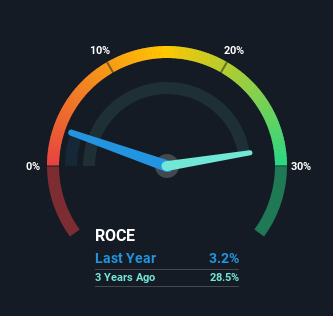Pantoro's (ASX:PNR) Returns On Capital Are Heading Higher
If you're looking for a multi-bagger, there's a few things to keep an eye out for. Firstly, we'll want to see a proven return on capital employed (ROCE) that is increasing, and secondly, an expanding base of capital employed. Put simply, these types of businesses are compounding machines, meaning they are continually reinvesting their earnings at ever-higher rates of return. So on that note, Pantoro (ASX:PNR) looks quite promising in regards to its trends of return on capital.
Return On Capital Employed (ROCE): What is it?
If you haven't worked with ROCE before, it measures the 'return' (pre-tax profit) a company generates from capital employed in its business. The formula for this calculation on Pantoro is:
Return on Capital Employed = Earnings Before Interest and Tax (EBIT) ÷ (Total Assets - Current Liabilities)
0.032 = AU$6.0m ÷ (AU$217m - AU$29m) (Based on the trailing twelve months to December 2020).
Therefore, Pantoro has an ROCE of 3.2%. Ultimately, that's a low return and it under-performs the Metals and Mining industry average of 9.8%.
Check out our latest analysis for Pantoro
In the above chart we have measured Pantoro's prior ROCE against its prior performance, but the future is arguably more important. If you're interested, you can view the analysts predictions in our free report on analyst forecasts for the company.
What Does the ROCE Trend For Pantoro Tell Us?
The fact that Pantoro is now generating some pre-tax profits from its prior investments is very encouraging. The company was generating losses five years ago, but now it's earning 3.2% which is a sight for sore eyes. And unsurprisingly, like most companies trying to break into the black, Pantoro is utilizing 692% more capital than it was five years ago. We like this trend, because it tells us the company has profitable reinvestment opportunities available to it, and if it continues going forward that can lead to a multi-bagger performance.
In another part of our analysis, we noticed that the company's ratio of current liabilities to total assets decreased to 13%, which broadly means the business is relying less on its suppliers or short-term creditors to fund its operations. This tells us that Pantoro has grown its returns without a reliance on increasing their current liabilities, which we're very happy with.
What We Can Learn From Pantoro's ROCE
To the delight of most shareholders, Pantoro has now broken into profitability. Considering the stock has delivered 33% to its stockholders over the last five years, it may be fair to think that investors aren't fully aware of the promising trends yet. Given that, we'd look further into this stock in case it has more traits that could make it multiply in the long term.
On a final note, we've found 1 warning sign for Pantoro that we think you should be aware of.
If you want to search for solid companies with great earnings, check out this free list of companies with good balance sheets and impressive returns on equity.
This article by Simply Wall St is general in nature. We provide commentary based on historical data and analyst forecasts only using an unbiased methodology and our articles are not intended to be financial advice. It does not constitute a recommendation to buy or sell any stock, and does not take account of your objectives, or your financial situation. We aim to bring you long-term focused analysis driven by fundamental data. Note that our analysis may not factor in the latest price-sensitive company announcements or qualitative material. Simply Wall St has no position in any stocks mentioned.
Have feedback on this article? Concerned about the content? Get in touch with us directly. Alternatively, email editorial-team (at) simplywallst.com.

